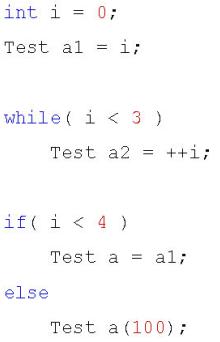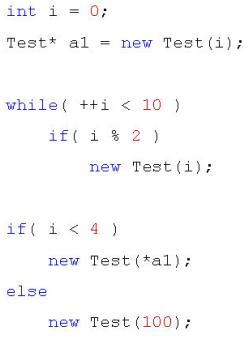C++筆記 第二十一課 物件的構造順序---狄泰學院
阿新 • • 發佈:2018-11-07
如果在閱讀過程中發現有錯誤,望評論指正,希望大家一起學習,一起進步。
學習C++編譯環境:Linux
第二十一課 物件的構造順序
問題:C++中的類可以定義多個物件,那麼物件構造的順序是怎樣的?
1.物件的構造順序一
對於 區域性物件
當程式執行流到達物件的定義語句時進行構造,物件定義->構造
下面程式中的物件構造順序是什麼?

21-1 區域性物件的構造順序
#include <stdio.h> class Test { private: int mi; public: Test(int i) { mi = i; printf("Test(int i): %d\n", mi); } Test(const Test& obj) { mi = obj.mi; printf("Test(const Test& obj): %d\n", mi); } }; int main() { int i = 0; Test a1 = i; //Test(int i):0 while( i < 3 ) { Test a2 = ++i; //Test(int i):1,2,3 } //goto End; if( i < 4 ) { Test a = a1; //Test(const Test& obj):0 } else { Test a(100); } //End: //此時不會輸出最後一個輸出結果 return 0; } 執行結果 Test(int i): 0 Test(int i): 1 Test(int i): 2 Test(int i): 3 Test(const Test& obj): 0
2.物件的構造順序二
對於 堆物件
當程式執行流到達new語句時建立物件
使用new建立物件將自動觸發建構函式的呼叫
下面程式中的物件構造順序是什麼?

21-2 堆物件的構造順序
#include <stdio.h> class Test { private: int mi; public: Test(int i) { mi = i; printf("Test(int i): %d\n", mi); } Test(const Test& obj) { mi = obj.mi; printf("Test(const Test& obj): %d\n", mi); } int getMi() { return mi; } }; int main() { int i = 0; Test* a1 = new Test(i); // Test(int i): 0 while( ++i < 10 ) if( i % 2 ) new Test(i); // Test(int i): 1, 3, 5, 7, 9 if( i < 4 ) new Test(*a1); else new Test(100); // Test(int i): 100 return 0; } 執行結果 Test(int i): 0 Test(int i): 1 Test(int i): 3 Test(int i): 5 Test(int i): 7 Test(int i): 9 Test(int i): 100
3.物件的構造順序三
[email protected]:~/c++/21-3$ g++ 21-3.cpp t2.cpp t1.cpp t3.cpp -o test.out
[email protected]:~/c++/21-3$ ./test.out
t4
t2
t1
t3
t5
對於 全域性物件
物件的構造順序是不確定的
不同的編譯器使用不同的規則確定構造順序
21-3 全域性物件的構造順序
小結
區域性物件的構造順序依賴於程式的執行流
堆物件的構造順序依賴於new的使用順序
全域性物件的構造順序是不確定的
